Design of Functionally Stacked Channels of Oxide Thin-Film Transistors to Mimic Precise Ultralow-Light-Irradiated Synaptic Weight Modulation
Abstract
:1. Introduction
2. Experimental Details
2.1. Fabrication of n-Type a-IGZO and a-IZO Thin-Film Transistors
2.2. Electrical Characterization
3. Results and Discussion
3.1. Synaptic Behavior by Optical Modulation in Biological/Artificial Visual System
3.2. Ideal Artificial Synapse Device for Optical Signal Detection
3.3. Electrical Characterization of a-IGZO and a-IZO TFTs
3.4. EPSC Characteristics of a-IGZO and a-IZO TFTs
3.5. Modulation of the Ar/O2 Ratio for Enhancing Photonic Performances
3.6. Emulation of Synaptic Behavior with IGZO/IZO Photonic Synapse Transistor
4. Conclusions
Supplementary Materials
Author Contributions
Funding
Conflicts of Interest
References
- Merolla, P.A.; Arthur, J.V.; Alvarez-Icaza, R.; Cassidy, A.S.; Sawada, J.; Akopyan, F.; Jackson, B.L.; Imam, N.; Guo, C.; Nakamura, Y.; et al. A million spiking-neuron integrated circuit with a scalable communication network and interface. Science 2014, 345, 668–673. [Google Scholar] [CrossRef]
- Zidan, M.A.; Strachan, J.P.; Lu, W.D. The future of electronics based on memristive systems. Nat. Electron. 2018, 1, 22–29. [Google Scholar] [CrossRef]
- Ho, V.M.; Lee, J.-A.; Martin, K.C. The cell biology of synaptic plasticity. Science 2011, 334, 623–628. [Google Scholar] [CrossRef] [Green Version]
- Abbott, L.F.; Regehr, W.G. Synaptic computation. Nature 2004, 431, 796–803. [Google Scholar] [CrossRef]
- Zhang, T.; Yang, K.; Xu, X.; Cai, Y.; Yang, Y.; Huang, R. Memristive devices and networks for brain-inspired computing. Phys. Status Solidi RRL 2019, 13, 1900029. [Google Scholar] [CrossRef]
- Fang, L.; Dai, S.; Zhao, Y.; Liu, D.; Huang, J. Light-stimulated artificial synapses based on 2D organic field-effect transistors. Adv. Electron. Mater. 2020, 6, 1901217. [Google Scholar] [CrossRef]
- Park, H.-L.; Lee, Y.; Kim, N.; Seo, D.-G.; Go, G.-T.; Lee, T.-W. Flexible neuromorphic electronics for computing, soft robotics, and neuroprosthetics. Adv. Mater. 2020, 32, 1903558. [Google Scholar] [CrossRef]
- Chen, S.; Lou, Z.; Chen, D.; Shen, G. An artificial flexible visual memory system based on an UV-motivated memristor. Adv. Mater. 2018, 30, 1705400. [Google Scholar] [CrossRef]
- Zhou, F.; Zhou, Z.; Chen, J.; Choy, T.H.; Wang, J.; Zhang, N.; Lin, Z.; Yu, S.; Kang, J.; Wong, H.-S.P.; et al. Optoelectronic resistive random access memory for neuromorphic vision sensors. Nat. Nanotechnol. 2019, 14, 776–782. [Google Scholar] [CrossRef]
- Xue, F.; He, X.; Wang, Z.; Retamal, J.R.D.; Chai, Z.; Jing, L.; Zhang, C.; Fang, H.; Chai, Y.; Jiang, T.; et al. Giant ferroelectric resistance switching controlled by a modulatory terminal for low-power neuromorphic in-memory computing. Adv. Mater. 2021, 33, 2008709. [Google Scholar] [CrossRef]
- Song, S.; Ham, W.; Park, G.; Kho, W.; Kim, J.; Hwang, H.; Kim, H.-B.; Song, H.; Ahn, J.-H.; Ahn, S.-E. Highly stable artificial synapses based on ferroelectric tunnel junctions for neuromorphic computing applications. Adv. Mater. Technol. 2022, 2022, 2101323. [Google Scholar] [CrossRef]
- Boybat, I.; Gallo, M.L.; Nandakumar, S.R.; Moraitis, T.; Parnell, T.; Tuma, T.; Rajendran, B.; Leblebici, Y.; Sebastian, A.; Eleftheriou, E. Neuromorphic computing with multi-memristive synapses. Nat. Commun. 2018, 9, 2514. [Google Scholar] [CrossRef] [PubMed]
- Jiao, F.; Chen, B.; Ding, K.; Li, K.; Wang, L.; Zeng, X.; Rao, F. Monatomic 2D phase-change memory for precise neuromorphic computing. Appl. Mater. Today 2020, 20, 100641. [Google Scholar] [CrossRef]
- Cho, S.W.; Kwon, S.M.; Kim, Y.-H.; Park, S.K. Recent progress in transistor-based optoelectronic synapses: From neuromorphic computing to artificial sensory system. Adv. Intell. Syst. 2021, 3, 2000162. [Google Scholar] [CrossRef]
- Xiang, D.; Liu, T.; Zhang, X.; Zhou, P.; Chen, W. Dielectric engineered two-dimensional neuromorphic transistors. Nano Lett. 2021, 21, 3557–3565. [Google Scholar] [CrossRef] [PubMed]
- Liu, Q.; Zhao, C.; Zhao, T.; Liu, Y.; Mitrovic, I.Z.; Xu, W.; Yang, L.; Zhao, C.Z. Ecofriendly solution-combustion-processed thin-film transistors for synaptic emulation and neuromorphic computing. ACS Appl. Mater. Interfaces 2021, 13, 18961–18973. [Google Scholar] [CrossRef]
- Alquraishi, W.; Sun, J.; Qiu, W.; Liu, W.; Huang, Y.; Jin, C.; Gao, Y. Mimicking optoelectronic synaptic functions in solution-processed In–Ga–Zn–O phototransistors. Appl. Phys. A 2020, 126, 431. [Google Scholar] [CrossRef]
- Li, H.K.; Chen, T.P.; Liu, P.; Hu, S.G.; Liu, Y.; Zhang, Q.; Lee, P.S. A light-stimulated synaptic transistor with synaptic plasticity and memory functions based on InGaZnOx–Al2O3 thin film structure. J. Appl. Phys. 2016, 119, 244505. [Google Scholar] [CrossRef]
- Yang, Y.; Wen, J.; Guo, L.; Wan, X.; Du, P.; Feng, P.; Shi, Y.; Wan, Q. Long-term synaptic plasticity emulated in modified graphene oxide electrolyte gated IZO-based thin-film transistors. ACS Appl. Mater. Interfaces 2016, 8, 30281–30286. [Google Scholar] [CrossRef]
- Kim, Y.-M.; Kim, E.-J.; Lee, W.-H.; Oh, J.-Y.; Yoon, S.-M. Short-term and long-term memory operations of synapse thin-film transistors using an In–Ga–Zn–O active channel and a poly(4-vinylphenol)–sodium β-alumina electrolytic gate insulator. RSC Adv. 2016, 6, 52913–52919. [Google Scholar] [CrossRef]
- Nomura, K.; Ohta, H.; Takagi, A.; Kamiya, T.; Hirano, M.; Hosono, H. Room-temperature fabrication of transparent flexible thin-film transistors using amorphous oxide semiconductors. Nature 2004, 432, 488–492. [Google Scholar] [CrossRef]
- Jeon, S.; Ahn, S.-E.; Song, I.; Kim, C.J.; Chung, U.-I.; Lee, E.; Yoo, I.; Nathan, A.; Lee, S.; Ghaffarzadeh, K.; et al. Gated three-terminal device architecture to eliminate persistent photoconductivity in oxide semiconductor photosensor arrays. Nat. Mater. 2012, 11, 301–305. [Google Scholar] [CrossRef] [PubMed]
- Kim, J.; Kim, Y.; Kwon, O.; Kim, T.; Oh, S.; Jin, S.; Park, W.; Kwon, J.-D.; Hong, S.-W.; Lee, C.-S.; et al. Modulation of synaptic plasticity mimicked in Al nanoparticle-embedded IGZO synaptic transistor. Adv. Electron. Mater. 2020, 6, 1901072. [Google Scholar] [CrossRef]
- Kim, Y.K.; Ahn, C.H.; Yun, M.G.; Cho, S.W.; Kang, W.J.; Cho, H.K. Periodically pulsed wet annealing approach for low-temperature processable amorphous InGaZnO thin film transistors with high electrical performance and ultrathin thickness. Sci. Rep. 2016, 6, 26287. [Google Scholar] [CrossRef] [PubMed] [Green Version]
- John, R.A.; Liu, F.; Chien, N.A.; Kulkarni, M.R.; Zhu, C.; Fu, Q.; Basu, A.; Liu, Z.; Mathews, N. Synergistic gating of electro-iono-photoactive 2D chalcogenide neuristors: Coexistence of hebbian and homeostatic synaptic metaplasticity. Adv. Mater. 2018, 30, 1800220. [Google Scholar] [CrossRef]
- Hao, D.; Zhang, J.; Dai, S.; Zhang, J.; Huang, J. Perovskite/organic semiconductor-based photonic synaptic transistor for artificial visual system. ACS Appl. Mater. Interfaces 2020, 12, 39487–39495. [Google Scholar] [CrossRef]
- Yang, B.; Lu, Y.; Jiang, D.; Li, Z.; Zeng, Y.; Zhang, S.; Ye, Y.; Liu, Z.; Ou, Q.; Wang, Y.; et al. Bioinspired multifunctional organic transistors based on natural chlorophyll/organic semiconductors. Adv. Mater. 2020, 32, 2001227. [Google Scholar] [CrossRef] [PubMed]
- Hsu, C.-C.; Chen, H.-P.; Ting, W.-C. Correlation between carrier concentration distribution, I–V and C–V characteristics of a-InGaZnO TFTs. J. Disp. Technol. 2016, 12, 328–337. [Google Scholar] [CrossRef]
- Du, J.; Xie, D.; Zhang, Q.; Zhong, H.; Meng, F.; Fu, X.; Sun, Q.; Ni, H.; Li, T.; Guo, E.-j.; et al. A robust neuromorphic vision sensor with optical control of ferroelectric switching. Nano Energy 2021, 89, 106439. [Google Scholar] [CrossRef]
- Seo, S.; Jo, S.-H.; Kim, S.; Shim, J.; Oh, S.; Kim, J.-H.; Heo, K.; Choi, J.-W.; Choi, C.; Oh, S.; et al. Artificial optic-neural synapse for colored and color-mixed pattern recognition. Nat. Commun. 2018, 9, 5106. [Google Scholar] [CrossRef] [PubMed]
- Wu, Q.; Wang, J.; Cao, J.; Lu, C.; Yang, G.; Shi, X.; Chuai, X.; Gong, Y.; Su, Y.; Zhao, Y.; et al. Photoelectric plasticity in oxide thin film transistors with tunable synaptic functions. Adv. Electron. Mater. 2018, 4, 1800556. [Google Scholar] [CrossRef]
- Jung, S.H.; Ahn, C.H.; Kim, Y.B.; Kim, D.S.; Deshpande, N.G.; Cho, H.K. Inactivation of low-temperature-induced numerous defects at the electrode/channel interfaces using ultrathin Al2O3 layers. Microelectron. Eng. 2019, 216, 111049. [Google Scholar] [CrossRef]
- Kwon, S.M.; Cho, S.W.; Kim, M.; Heo, J.S.; Kim, Y.-H.; Park, S.K. Environment-adaptable artificial visual perception behaviors using a light-adjustable optoelectronic neuromorphic device array. Adv. Mater. 2019, 31, 1906433. [Google Scholar] [CrossRef] [PubMed]
- Yu, J.J.; Liang, L.Y.; Hu, L.X.; Duan, H.X.; Wu, W.H.; Zhang, H.L.; Gao, J.H.; Zhuge, F.; Chang, T.C.; Cao, H.T. Optoelectronic neuromorphic thin-film transistors capable of selective attention and with ultra-low power dissipation. Nano Energy 2019, 62, 772–780. [Google Scholar] [CrossRef]
- Cho, S.W.; Kwon, S.M.; Lee, M.K.; Jo, J.-W.; Heo, J.S.; Kim, Y.-H.; Cho, H.K.; Park, S.K. Multi-spectral gate-triggered heterogeneous photonic neuro-transistors for power-efficient brain-inspired neuromorphic computing. Nano Eng. 2019, 66, 104097. [Google Scholar] [CrossRef]
- Tak, Y.J.; Yoon, D.H.; Yoon, S.; Choi, U.H.; Sabri, M.M.; Ahn, B.D.; Kim, H.J. Enhanced electrical characteristics and stability via simultaneous ultraviolet and thermal treatment of passivated amorphous In−Ga−Zn−O thin-film transistors. ACS Appl. Mater. Interfaces 2014, 6, 6399–6405. [Google Scholar] [CrossRef] [PubMed]
- Bang, J.; Matsuishi, S.; Hosono, H. Hydrogen anion and subgap states in amorphous In–Ga–Zn–O thin films for TFT applications. Appl. Phys. Lett. 2017, 110, 232105. [Google Scholar] [CrossRef] [Green Version]
- Kim, J.; Bang, J.; Nakamura, N.; Hosono, H. Ultra-wide bandgap amorphous oxide semiconductors for NBIS-free thin-film transistors. APL Mater. 2019, 7, 022501. [Google Scholar] [CrossRef] [Green Version]
- Ohno, T.; Hasegawa, T.; Tsuruoka, T.; Terabe, K.; Gimzewski, J.K.; Aono, M. Short-term plasticity and long-term potentiation mimicked in single inorganic synapses. Nat. Mater. 2011, 10, 591–595. [Google Scholar] [CrossRef] [PubMed]
- Kakalios, J.; Street, R.A.; Jackson, W.B. Stretched-exponential relaxation arising from dispersive diffusion of hydrogen in amorphous silicon. Phys. Rev. Lett. 1987, 59, 1037–1040. [Google Scholar] [CrossRef] [PubMed]
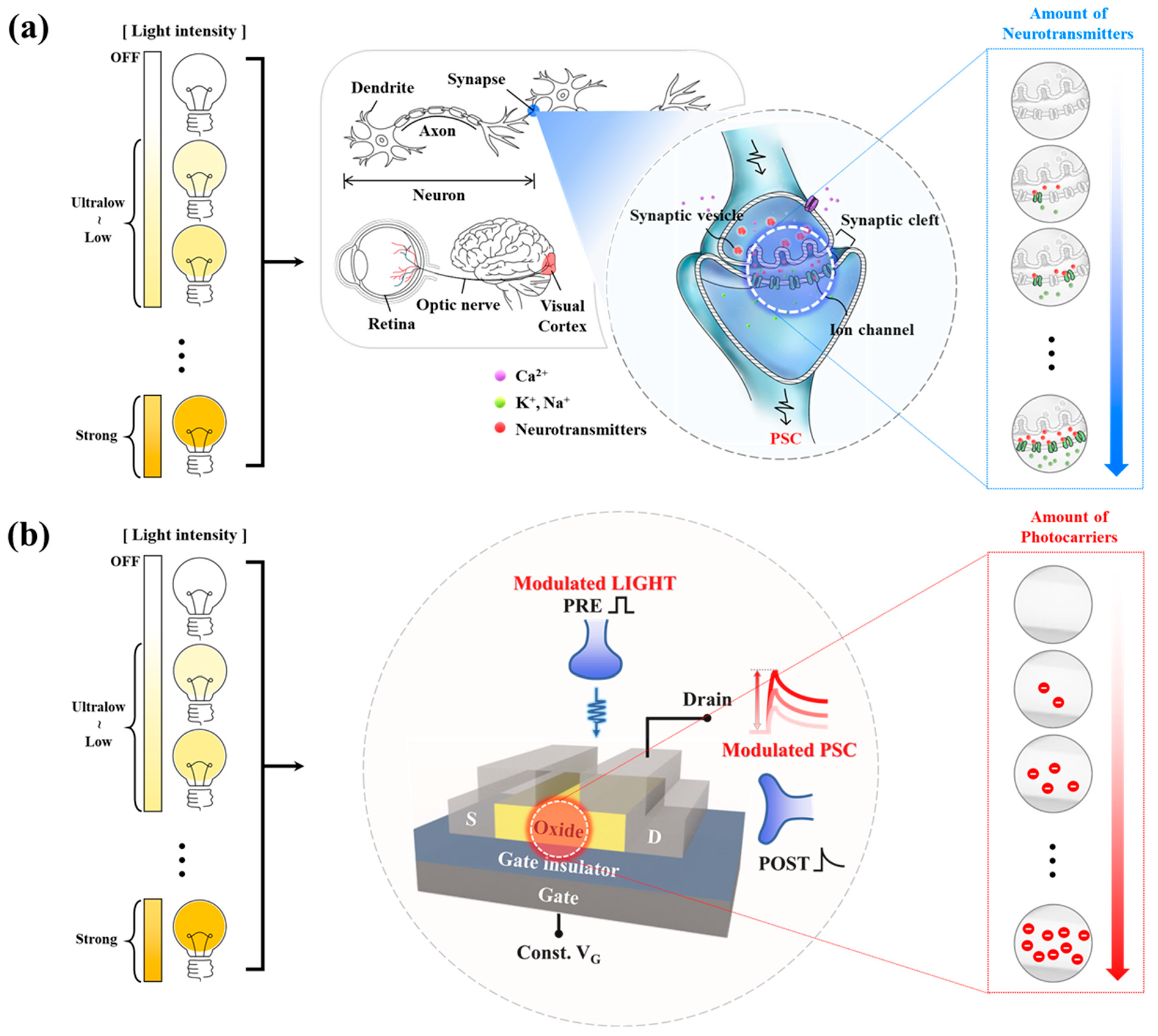
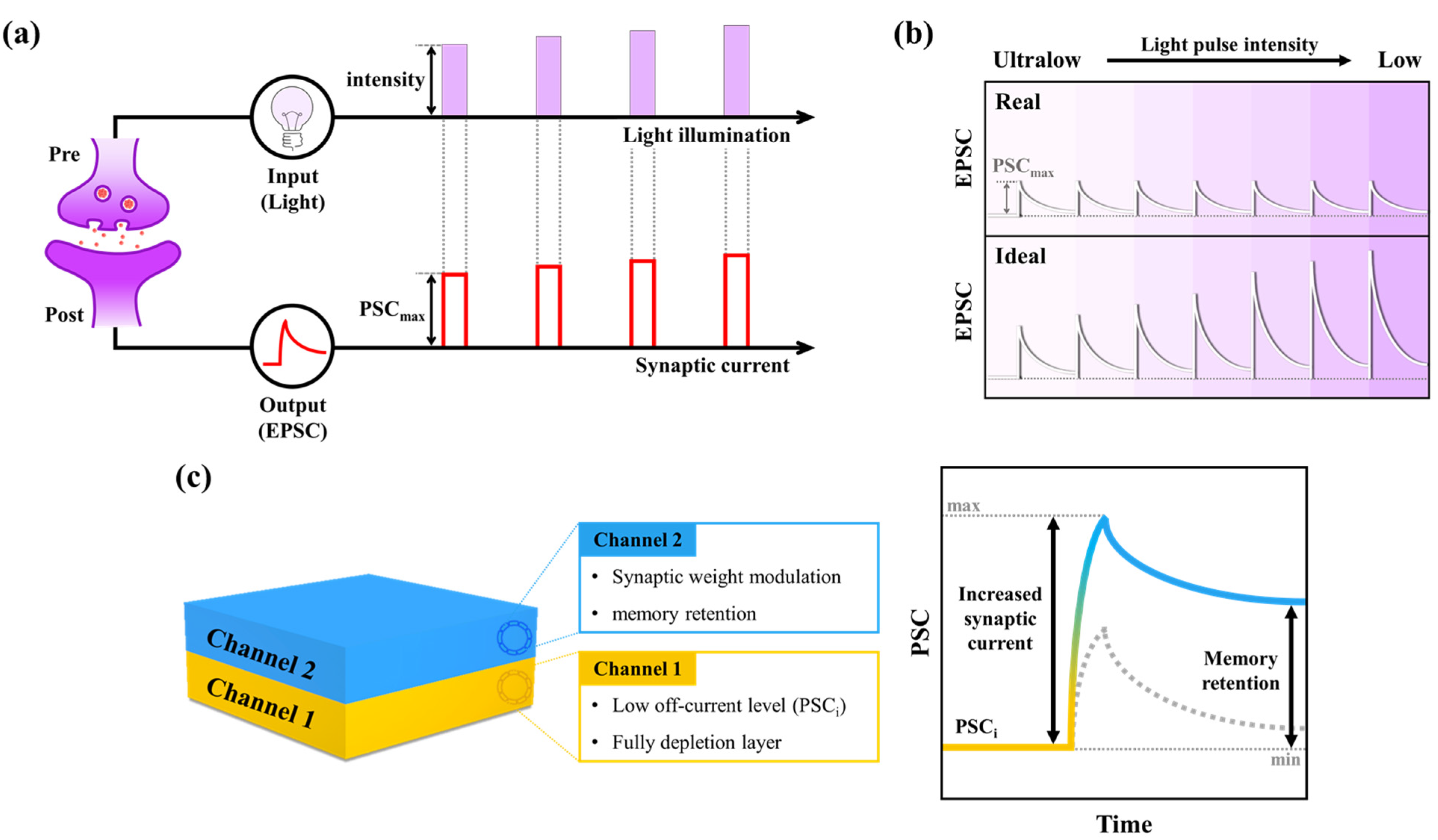
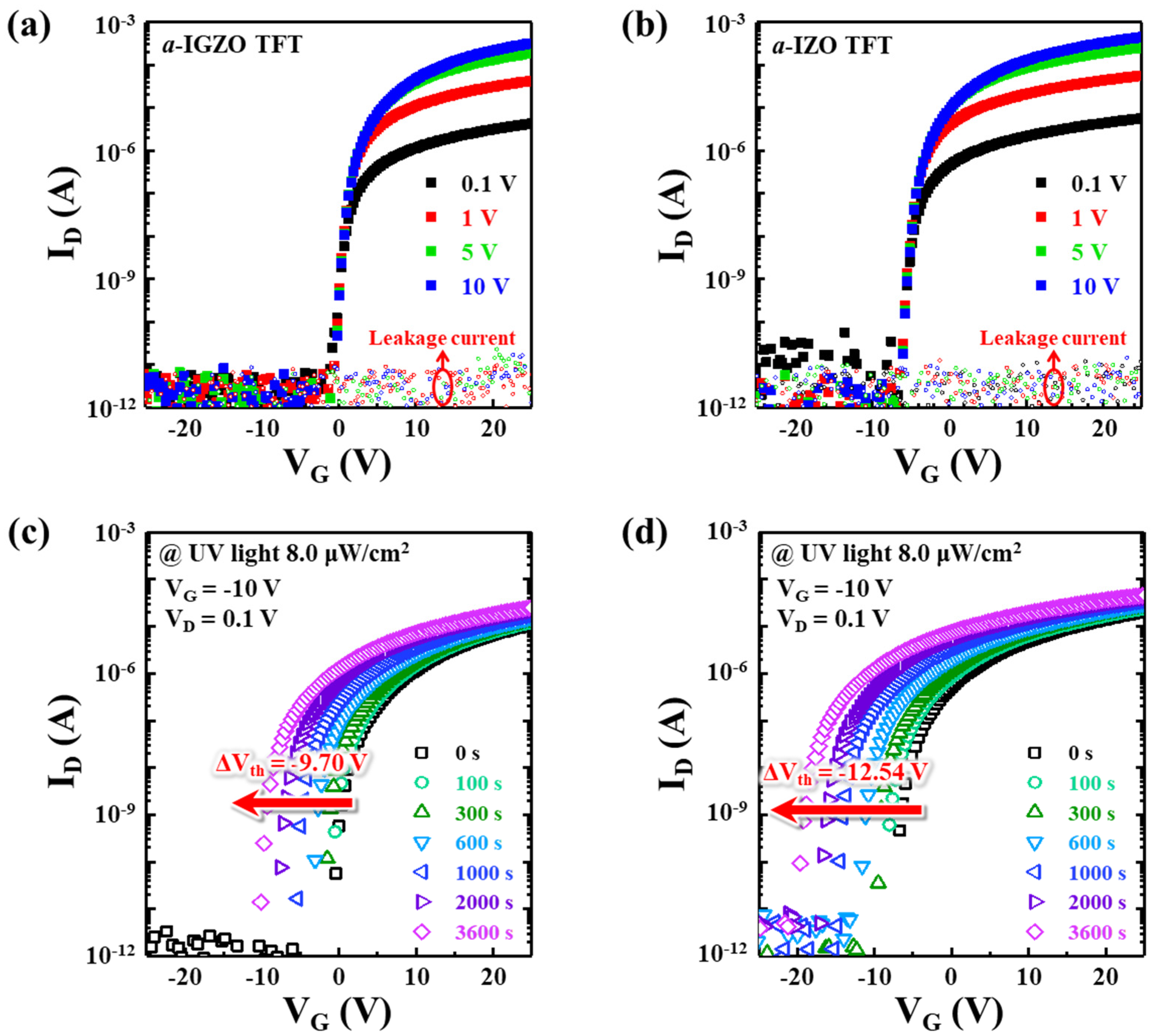
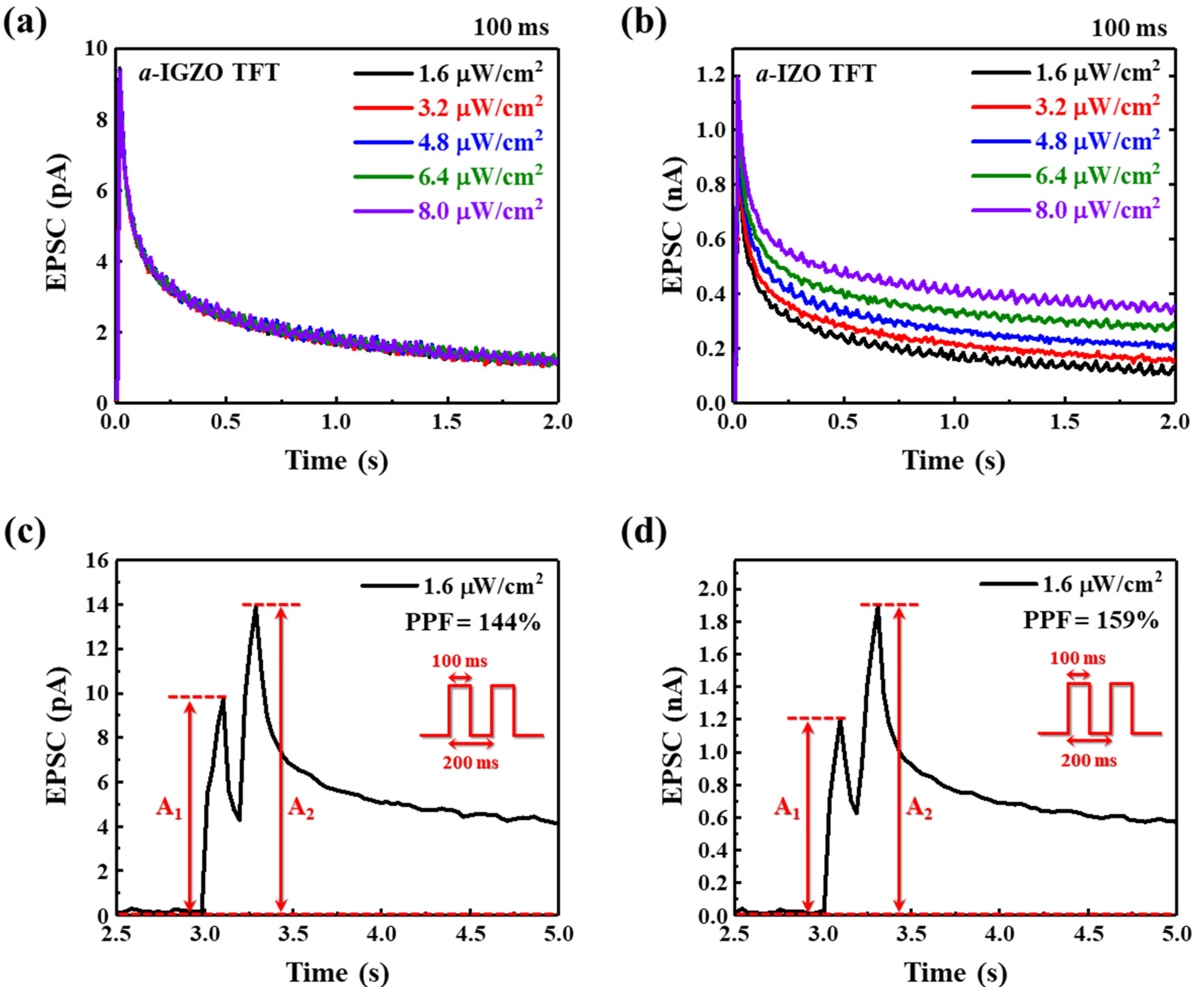
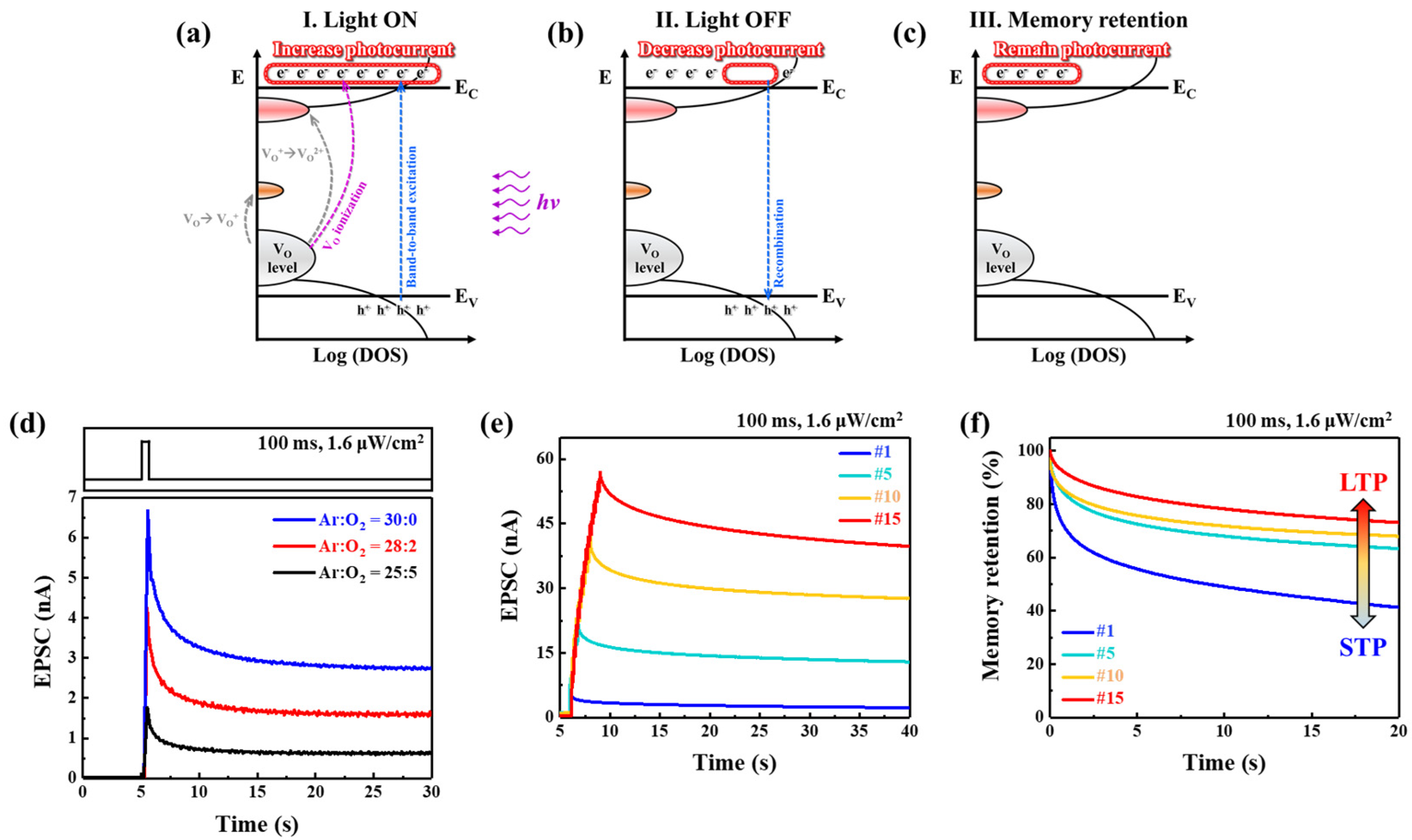
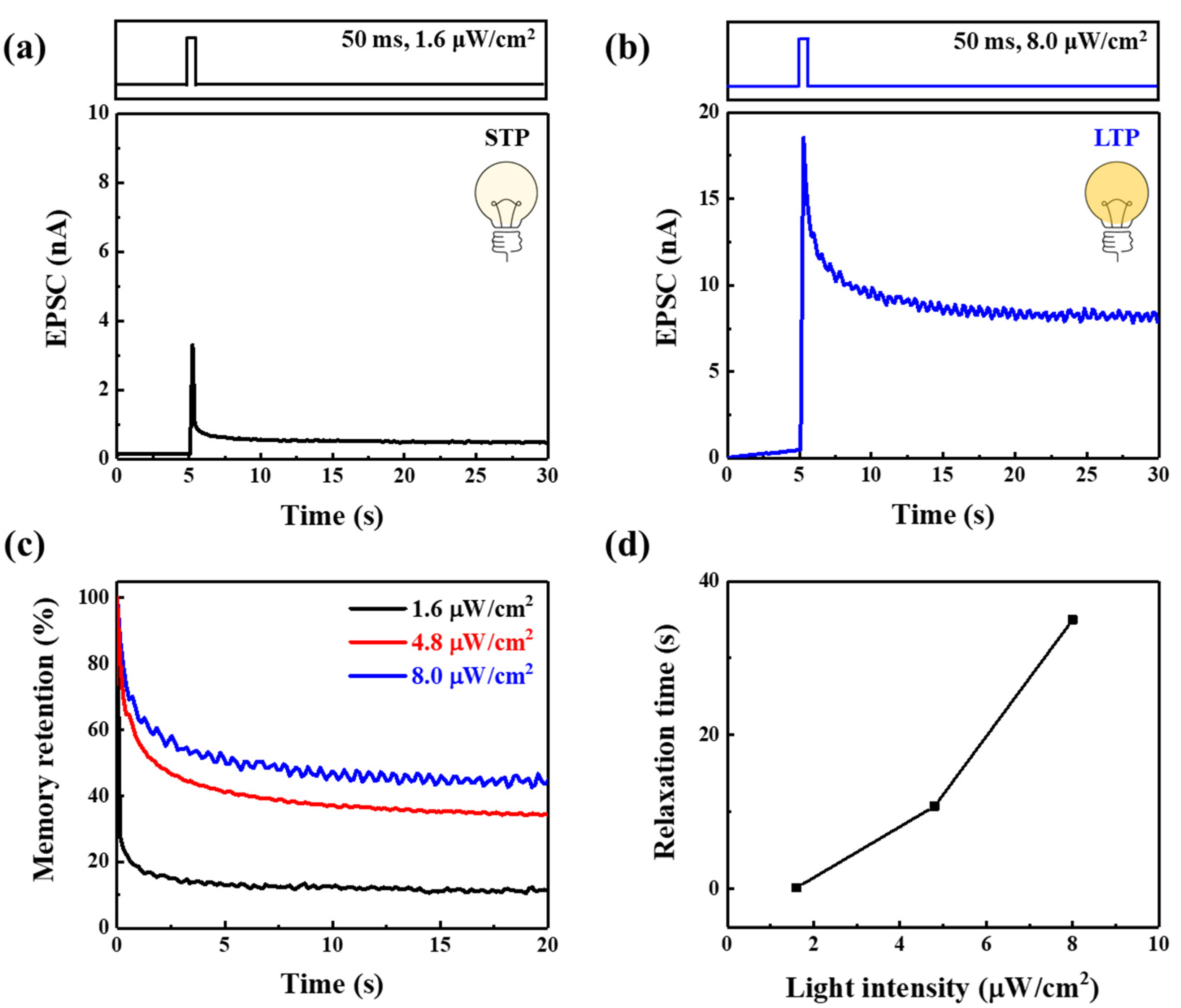
Publisher’s Note: MDPI stays neutral with regard to jurisdictional claims in published maps and institutional affiliations. |
© 2022 by the authors. Licensee MDPI, Basel, Switzerland. This article is an open access article distributed under the terms and conditions of the Creative Commons Attribution (CC BY) license (https://creativecommons.org/licenses/by/4.0/).
Share and Cite
Yang, J.S.; Jung, S.H.; Kim, D.S.; Choi, J.H.; Suh, H.W.; Lee, H.H.; Lee, K.W.; Cho, H.K. Design of Functionally Stacked Channels of Oxide Thin-Film Transistors to Mimic Precise Ultralow-Light-Irradiated Synaptic Weight Modulation. Micromachines 2022, 13, 526. https://doi.org/10.3390/mi13040526
Yang JS, Jung SH, Kim DS, Choi JH, Suh HW, Lee HH, Lee KW, Cho HK. Design of Functionally Stacked Channels of Oxide Thin-Film Transistors to Mimic Precise Ultralow-Light-Irradiated Synaptic Weight Modulation. Micromachines. 2022; 13(4):526. https://doi.org/10.3390/mi13040526
Chicago/Turabian StyleYang, Ji Sook, Sung Hyeon Jung, Dong Su Kim, Ji Hoon Choi, Hee Won Suh, Hak Hyeon Lee, Kun Woong Lee, and Hyung Koun Cho. 2022. "Design of Functionally Stacked Channels of Oxide Thin-Film Transistors to Mimic Precise Ultralow-Light-Irradiated Synaptic Weight Modulation" Micromachines 13, no. 4: 526. https://doi.org/10.3390/mi13040526
APA StyleYang, J. S., Jung, S. H., Kim, D. S., Choi, J. H., Suh, H. W., Lee, H. H., Lee, K. W., & Cho, H. K. (2022). Design of Functionally Stacked Channels of Oxide Thin-Film Transistors to Mimic Precise Ultralow-Light-Irradiated Synaptic Weight Modulation. Micromachines, 13(4), 526. https://doi.org/10.3390/mi13040526






